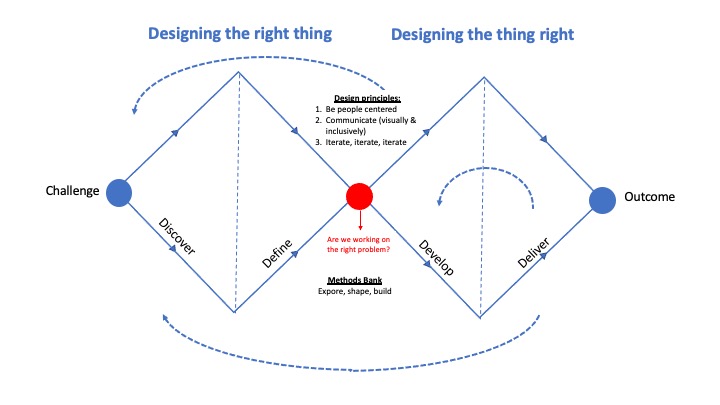Figure 1: Build-Measure-Learn Cycle
Recommendations for action |
|
Design thinking methodology
In general, the Design Thinking approach can be divided into two phases, whereby a problem is first explored in repetitive cycles, which can then lead to a methodically guided solution finding process
Problem exploration before solution finding (diverging): In the problem exploration phase, the following action maxim applies, resulting from the uncertainty and complexity of the Wicked Problems: avoid postulating solutions or solution approaches without critically questioning the challenge (or the supposed problem or task), to examine it in depth, and to remain open to the design of the problem. In this process, the assumptions and knowledge in the design team about the challenges of the users are explicitly addressed and critically examined. The team members work out their underlying assumptions with each other and reflect on them in an inter- and multidisciplinary exchange. The objective is not to agree on a common problem definition for the team. Rather, the aim is to identify and present the potential for conflict and friction between the various assumptions. In addition, the assumptions and knowledge about the problems of the users are confronted with the perspectives and life worlds of the users through user research, with the help of qualitative methods of the social sciences. he team's reflection and the confrontation with the users' perspectives enable the design team to reveal new lines of sight on complex challenges and thus to open up new or innovative solution spaces. Only when the challenge has been redefined (often referred to as Creative Reframing) do design teams turn to finding a solution. Here, problem exploration is at least as important (if not more important) and time-consuming as the solution-finding process.
Solution space exploration including prototyping (converging):
In the solution space, design teams use ideation methods such as various brainstorming techniques to populate the newly defined solution space with as many ideas as possible. Since, as we have seen, multidisciplinary collaboration does not eliminate or neutralize the inherent uncertainty of complex problems - the so-called Wicked Problems - ("only" enables practical approaches to these problems), design teams in this phase aim to generate as many radical ideas as possible. This collection of ideas and potential solutions (the larger and more radical the collection, the better) reflects the recognition (or acceptance) that complex problems and their potential solutions involve fundamental uncertainty. Every solution idea is a hypothesis which must first be empirically tested for usefulness. Prototypes that can be experienced, tested and improved with users are suitable for this purpose. User tests allow the design team to gain new insights into their solutions, the prototypical implementation of the solution, and (inevitably) into the users themselves and their lifeworld. In this sense, user tests (analogous to the process of creative reframing in the problem space) are a gateway to or a way back into the problem space (see Figure 2).

Figure 2: Double-Diamond-Modell from the Design Council (Design Council, UK)
Design Thinking Principles
The Design Thinking procedures can be derived from the principles of Design Thinking as a solution process for Wicked Problems. Wicked problems, as already mentioned, are characterized by both high complexity and profound uncertainty. The basic principles of design thinking address these two characteristics: Multidisciplinary collaboration allows for constructive engagement with complexity, while iterative problem-solving allows for pragmatic engagement with the fundamental uncertainty of these challenges. Multidisciplinary collaboration: If we assume that agile working methods such as design thinking are particularly suitable for solving complex problems, then a correspondingly large number of problem-solving skills must be represented in the teams. The term "multidisciplinary" - actually a term from the university or scientific environment - can be perceived as a barrier to the implementation of agile methods. This type of collaboration is less about an interaction of people with qualifications from different academic disciplines than about a collaboration of people with different and ideally conflicting perspectives on a complex problem in the design process. In public administration, this can include not only diverse expertise from different departments, but also perspectives that result from different life experiences and situations of citizens. e objective of this collaboration is to deal with the complexity of Wicked Problems by creatively integrating and synthesizing as many different perspectives as possible. Iterative solution development: In addition to complexity, Design Thinking teams also have to deal with the knowledge ambivalence of Wicked Problems. Here, the "uncertainty of knowledge" does not indicate ignorance, i.e., a lack of knowledge. On the contrary, there is often a great deal of knowledge (both scientific and otherwise) about Wicked Problems-such as climate change, child poverty, homelessness, or crime. Uncertainty" in this case means that this knowledge is not necessarily actionable, or that the implications of action still leave much room for interpretation - and thus for discussion n short, although we know a lot about Wicked Problems, we argue about how to translate this knowledge into effective solutions and actions. However, applicability is not necessarily eliminated by collaboration in multidisciplinary teams. In other words, the new user-centered viewpoint with which teams look at complex problems that emerge from the process of creative reframing is not based on an absolute claim to truth. At best, these are hypotheses about how the complex problems at hand could be sensibly addressed. By quickly translating insights into ideas and in turn into tangible prototypes, design teams are able to confront their hypotheses relatively quickly with (empirical) data through user testing. This is actually not a validation in the strict scientific sense, but a first falsification: Ideally, design teams actively search for errors and misinterpretations as well as for weaknesses and potential causes that could have led to a failure of the idea/solution. This implies that the failure of a solution is actively caused and provoked in experimental test environments. Accordingly, iterative work - the process represented by the build-measure-learn cycle - is not the "one" course of action (in case the idea does not work out), but an integral part of the innovative way of working: Without iteration, there is no real Design Thinking. For the public administration, these internal tests are immensely important, because failure happens, if possible, not at the time of the actual publication of a solution, but long beforehand, and the design teams can make improvements (see Figure 3).
| Phase | ||
| Problem space | Solution space | |
Design- Thinking methods | Diverging/Exploring: Understanding and observing
| Diverging/Developing: Finding ideas
Converge/Create: Prototype and testing
|
|
Figure 3: Overview of methods per Design Thinking phase
Literature
Bason, C. (2010): Leading Public Sector Innovation: Co-Creating for a Better Society, Polity Press, Bristol, UK.
Design Council (o. A.): What ist the framework for innovation? Design Councils evolved Double Diamond, go.sn.pub/fQOC0p
Lewrick, M., Link, P., Leifer, L. (2017): Das Design Thinking Playbook: mit traditionellen, aktuellen und zukünftigen Erfolgsfaktoren, München.
Liden, R. C., Wayne, S. J., Zhao, H., Henderson, D. (2008): Servant Leadership Scale, The Leadership Quarterly.
Martin, R. L., (2009): The opposable mind: Winning through integrative thinking, Cambridge, Massachusetts.
Norman, D. (2013): The design of everyday things: Revised and expanded edition, Basic books.
Ries, E. (2011): The Lean Startup. New York.
Rittel, H., Webber, M. (1973): Dilemmas in a General Theory of Planning, Policy Sciences, 4, S. 155-69.
Dr. Steven Ney

